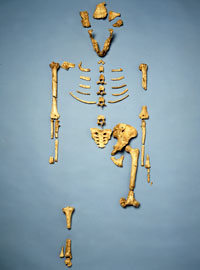Australopithecus afarensis ('Lucy')

What Australopithecus afarensis might have looked like. © John Sibbick / Natural History Museum
Australopithecus afarensis lived between about 3.8 and 3.0 million years ago in eastern Africa.
Thanks to the discovery of a relatively complete fossil skeleton, known as Lucy, A. afarensis is one of the best-known early hominin (human-like) species. Lucy transformed our thinking about how early hominins walked.
If you have a webcam, you can watch Lucy walking around your room.
Lucy - the most complete skeleton

Cast of the partial skeleton of Lucy, Australopithecus afarensis. The shape of the hips and limb bones show that this species was bipedal.
A. afarensis is known from many fossil finds in Tanzania, Kenya and Ethiopia, but Lucy is particularly important because she is the most complete and well-preserved afarensis fossil ever found.
Unearthed in 1974, around 40% of her full skeleton was recovered, making her the most complete skeleton of an early human relative known at the time. This relative completeness helped scientists begin to understand how early human-like species walked on 2 legs (bipedally).
However, the honour of being the most complete ancient hominin skeleton now goes to a 4.4-million-year-old Ardipithecus ramidus fossil known as Ardi, revealed in 2009.
A. afarensis was once thought to be the earliest human relative to habitually walk upright, but there is now some evidence to suggest earlier species, including A. ramidus, also walked bipedally.
Ape-like characteristics
The brain size of A. afarensis was ape-like, and there is no evidence so far of tool-making.
A. afarensis was evidently similar to living apes in terms of diet, aspects of biology, growth and development. Males of the species were much larger than females, showing high sexual dimorphism.
Habitat and way of life
The habitat of A. afarensis was probably a mix of woodland, where they foraged for food on the ground and in trees, along with more open areas where they would have walked upright.
Evidence from their teeth suggest that this hominin ate soft fruits and leaves but was also adapted to eat harder, more brittle foods too.
A. afarensis fossils are providing us with vital clues as to what hominin life was like after upright walking emerged and before the use of tools transformed human evolution.